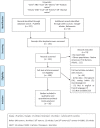History of dental caries in Inuit populations: genetic implications and 'distance effect'
- PMID: 37643455
- PMCID: PMC10467516
- DOI: 10.1080/22423982.2023.2252568
History of dental caries in Inuit populations: genetic implications and 'distance effect'
Abstract
Dental caries is considered the third most important scourge in the world. In North America, Inuit populations are the population the most severely affected by dental caries. It is often assumed that this situation can be explained by a combination of factors classical for Indigenous populations: remoteness (geographical distance), low economic status and low health literacy (cultural distance). Using a bibliographic approach, we tested this hypothesis of the "distance effect" by exploring the caries prevalence in other Indigenous populations living in high-income countries. Next, we tested whether the high prevalence of caries is due to population-specific characteristics by tracking caries prevalence over the past few centuries. In result, we showed that while other Indigenous populations are more impacted by caries than the general populations, the Inuit populations present the highest prevalence. Paradoxically, we showed also that past Inuit populations were almost immune to caries before 1950. These two elements suggest that the prevalence of caries observed presently is a recent maladaptation and that beyond the effect of cultural and geographical distance, specific biocultural factors have to be investigated.
Keywords: Caries prevalence; Inuit; distance; indigenous populations; risks factors.
Conflict of interest statement
No potential conflict of interest was reported by the authors.
Figures








Similar articles
-
Prevalence of dental caries among Indigenous populations compared to non-Indigenous populations: a quantitative systematic review protocol.JBI Evid Synth. 2021 Nov;19(11):3096-3101. doi: 10.11124/JBIES-20-00449. JBI Evid Synth. 2021. PMID: 34001779
-
Trends in caries prevalence in North American children.Int Dent J. 1994 Aug;44(4 Suppl 1):403-13. Int Dent J. 1994. PMID: 7814108
-
The prevalence and patterns of dental caries in Labrador Inuit youth.J Public Health Dent. 1994 Summer;54(3):132-8. doi: 10.1111/j.1752-7325.1994.tb01204.x. J Public Health Dent. 1994. PMID: 7932348
-
A Systematic Review of Musculoskeletal Fitness Among Indigenous Populations in North America and Circumpolar Inuit Populations.J Phys Act Health. 2020 Mar 1;17(3):384-395. doi: 10.1123/jpah.2018-0702. J Phys Act Health. 2020. PMID: 32050161
-
Oral health interventions among Indigenous populations in Canada.Int Dent J. 2010 Jun;60(3 Suppl 2):229-34. Int Dent J. 2010. PMID: 20718308 Review.
References
-
- Institute of Health Metrics and Evaluation (IHME) . Global burden of disease collaborative network. global burden of disease study 2019 (GBD 2019). 2020.
-
- Peres MA, Macpherson LMD, Weyant RJ, et al. Oral diseases: a global public health challenge. Lancet Lond Engl. 2019. juill 20;394(10194):249‑60. - PubMed
-
- Selwitz RH, Ismail AI, Pitts NB.. Dental caries. Lancet Lond Engl. 2007. janv 6;369(9555):51‑9. - PubMed
-
- Shetty A. Significance of sugar intake in young adults: a review. Int J Adolesc Med Health. 2021. oct 26;33(6):375‑8. - PubMed
MeSH terms
LinkOut - more resources
Full Text Sources
Medical
Miscellaneous
